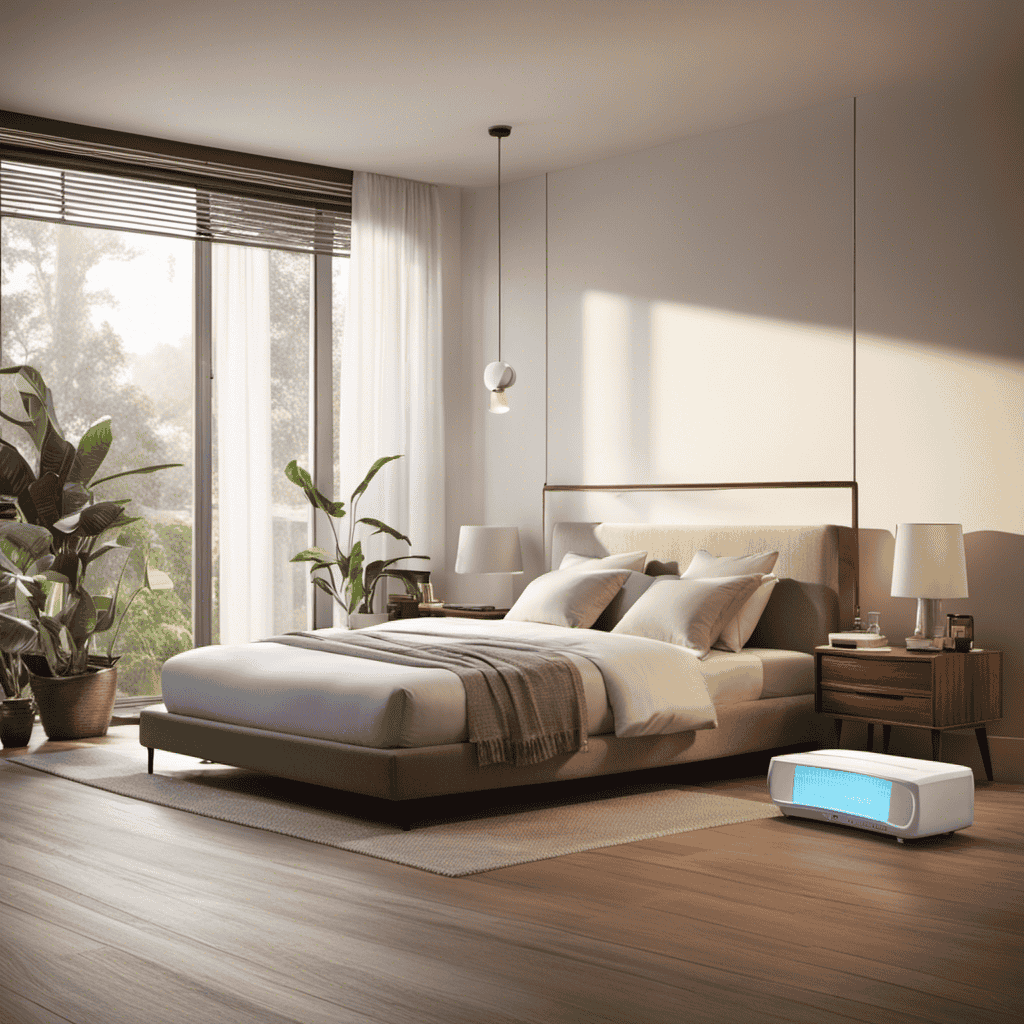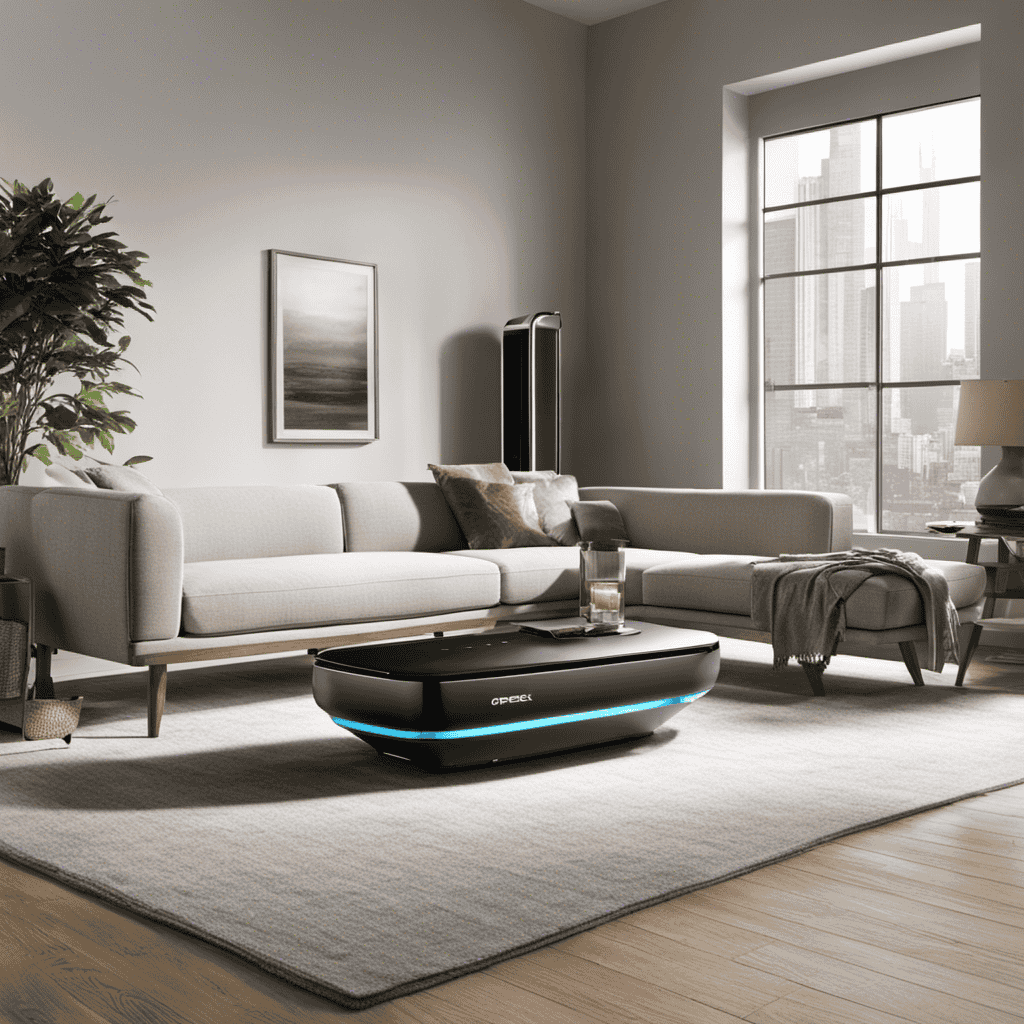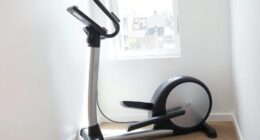I have always had difficulty with asthma, and finding effective ways to manage it is a major focus for me. This is why I wanted to investigate the question: Can air purifiers assist with asthma?
In this article, we’ll delve into the science behind air purifiers and their potential benefits for asthma sufferers. We’ll also discuss key features to look for when choosing an air purifier and share tips for using them to improve indoor air quality.
Let’s dive in and find out if air purifiers can truly make a difference for those with asthma.
Key Takeaways
- Air purifiers can remove allergens and pollutants, improving indoor air quality for asthma sufferers.
- Studies have shown that air purifiers can decrease asthma symptoms and reduce the need for medication.
- Clean air can help prevent asthma attacks and improve overall lung function.
- Choosing an air purifier with HEPA filters that capture 99.97% of particles as small as 0.3 microns is crucial for effective asthma management.
Understanding Asthma: A Brief Overview
Asthma is a chronic respiratory condition that affects the airways in the lungs. As someone who has lived with asthma for several years now, I can tell you that understanding the triggers and symptoms is crucial in managing this condition effectively.
Asthma triggers can vary from person to person, but there are some common ones that many people with asthma experience. These triggers can include allergens such as pollen, dust mites, pet dander, and mold. Irritants like smoke, strong odors, and air pollution can also trigger asthma symptoms. Certain respiratory infections, exercise, and even emotional stress can act as triggers as well.
The symptoms of asthma can range from mild to severe and can vary from person to person. Common symptoms include wheezing, coughing (especially at night), shortness of breath, and chest tightness. These symptoms can be intermittent or persistent, and their severity can also vary.
It is important to note that while these triggers and symptoms are common, each individual with asthma may experience them differently. It is crucial for individuals with asthma to work closely with their healthcare provider to develop a personalized management plan that includes avoiding triggers, taking prescribed medications, and using rescue inhalers as needed.
The Role of Air Quality in Asthma Management
Improving the quality of the air you breathe can greatly impact your management of asthma. As someone who has been living with asthma for years, I have learned firsthand the importance of clean air in reducing asthma symptoms and improving overall lung function.
Air pollution has a significant impact on asthma, triggering symptoms and exacerbating the condition. It is crucial to minimize exposure to pollutants such as particulate matter, ozone, and nitrogen dioxide, as they can irritate the airways and lead to inflammation.
One of the most effective ways to achieve cleaner air is by using air purifiers. These devices work by removing harmful pollutants from the indoor environment, creating a healthier and safer space for individuals with asthma. Air purifiers can capture and trap allergens such as dust mites, pollen, pet dander, and mold spores, which are common triggers for asthma attacks. By reducing the presence of these triggers, air purifiers can significantly improve the air quality in your home and help manage asthma symptoms.
Studies have shown that using air purifiers in homes with asthma sufferers can lead to a decrease in asthma symptoms, including coughing, wheezing, and shortness of breath. In addition to reducing symptoms, clean air can also help prevent asthma attacks and reduce the need for medication. By providing a cleaner and healthier environment, air purifiers offer numerous benefits for individuals with asthma.
How Air Purifiers Work
Using air purifiers can significantly enhance the quality of the air you breathe by removing harmful pollutants and allergens. Air purifiers work by utilizing various technologies to capture and eliminate airborne contaminants. Here’s how they do it:
-
High-efficiency particulate air (HEPA) filters: These filters are designed to trap particles as small as 0.3 microns, capturing allergens like dust mites, pollen, pet dander, and mold spores.
-
Activated carbon filters: These filters are excellent for adsorbing odors, smoke, and volatile organic compounds (VOCs) by chemically bonding with the pollutants.
-
Ultraviolet (UV) light technology: UV light can neutralize bacteria, viruses, and other microorganisms by damaging their DNA and preventing them from reproducing.
-
Ionizers: Ionizers release negatively charged ions into the air, causing pollutants to stick to surfaces or be attracted to positively charged plates inside the purifier.
-
Ozone generators: Although controversial, ozone generators can help eliminate odors and kill mold and bacteria. However, it’s important to use them in a controlled manner and ensure adequate ventilation.
To maintain the effectiveness of your air purifier, regular maintenance is key. This includes replacing filters as recommended by the manufacturer, cleaning the unit regularly, and keeping windows and doors closed to prevent the entry of outside pollutants.
Key Features to Look for in an Air Purifier for Asthma
When it comes to choosing an air purifier for asthma, there are several key features to consider.
One of the most important factors is the effectiveness of the filtration methods used. Look for an air purifier that utilizes HEPA filters, which are proven to capture 99.97% of particles as small as 0.3 microns.
Additionally, targeted allergen removal is crucial for asthma sufferers, so consider models that have specialized filters for common triggers like pet dander, pollen, and mold spores.
Lastly, pay attention to the air circulation capacity of the purifier, as a higher CADR (Clean Air Delivery Rate) ensures that the unit can efficiently clean the air in larger rooms or open spaces.
Effective Filtration Methods
One of the most effective ways to filter the air and reduce asthma triggers is by using a HEPA filter in an air purifier. HEPA stands for High Efficiency Particulate Air, and it is known for its ability to capture tiny particles as small as 0.3 microns in size. This makes it highly effective in removing common asthma triggers such as dust mites, pollen, pet dander, and mold spores.
When looking for an air purifier with a HEPA filter, it is important to consider the following:
- Filter Replacement: Look for air purifiers with easily replaceable filters to ensure optimal performance.
- Noise Level: Consider the noise level of the air purifier, especially if you plan to use it in your bedroom.
- Room Size: Check the recommended room size for the air purifier to ensure it can effectively filter the air in your space.
- Energy Efficiency: Look for energy-efficient models to save on electricity costs.
- Trusted Brands: Consider reputable air purifier brands that have a proven track record in filtration technologies.
Targeted Allergen Removal
To effectively target allergens in your home, consider investing in an air purifier with specialized filters designed to capture specific asthma triggers.
These filters are specifically designed to remove allergens such as dust mites, pet dander, pollen, and mold spores from the air, reducing the presence of asthma triggers in your living environment.
By targeting and removing these allergens, air purifiers can help alleviate asthma symptoms and improve overall air quality.
Studies have shown that air purifiers with HEPA filters can effectively reduce allergens in the air, leading to a decrease in asthma symptoms and improved respiratory health.
Additionally, some air purifiers also come with activated carbon filters, which can further remove odors and chemicals from the air, providing an added benefit for those with asthma.
Overall, investing in an air purifier with specialized filters can be an effective strategy for targeted allergen removal and reducing asthma triggers in your home.
Air Circulation Capacity
Now that we understand how targeted allergen removal is an important feature of air purifiers, let’s discuss another crucial factor: air circulation capacity.
Air purifiers work by drawing in the surrounding air and passing it through a series of filters to remove pollutants. The effectiveness of an air purifier largely depends on its ability to circulate and clean a sufficient amount of air in a given space.
Here are some benefits of air purifiers with high air circulation capacity:
-
Improved indoor air quality: A powerful air purifier can effectively remove harmful particles like dust, pollen, pet dander, and mold spores, improving the overall air quality.
-
Reduction of asthma triggers: By removing allergens and irritants from the air, air purifiers can help reduce asthma triggers and alleviate symptoms.
-
Enhanced respiratory health: Clean air promotes better breathing, reducing the risk of respiratory conditions and improving overall respiratory health.
-
Elimination of odors: Air purifiers with high air circulation capacity can remove unpleasant odors from the air, creating a fresh and clean environment.
-
Allergy relief: By capturing and eliminating allergens, air purifiers can provide relief to allergy sufferers and help manage their symptoms.
Types of Air Purifiers: Pros and Cons
When it comes to choosing an air purifier, two common types that often come up are HEPA filters and ionizers. Understanding the pros and cons of each can help make an informed decision.
Additionally, noise level impact is another important factor to consider, especially if you plan on using the air purifier in your bedroom or office.
Lastly, you should also consider the maintenance requirements and cost associated with the air purifier, as these factors can vary greatly depending on the type and brand you choose.
HEPA Vs. Ionizers
HEPA filters are more effective at trapping small particles compared to ionizers. When it comes to choosing the right air purifier, it’s important to understand the differences between these two options. Here are some key points to consider:
- HEPA filters use a dense mesh to physically trap particles, including allergens and pollutants.
- Ionizers release negatively charged ions, which attach to airborne particles and make them fall to the ground or stick to surfaces.
- HEPA filters are more efficient at removing smaller particles, which is crucial for reducing asthma triggers.
- Ionizers can produce ozone as a byproduct, which can be harmful to those with respiratory conditions.
- Electrostatic precipitators, a type of ionizer, can generate a small amount of ozone but are more effective at capturing larger particles.
Understanding the differences between HEPA filters and ionizers is essential when choosing an air purifier for asthma management.
Now, let’s explore another important aspect: the impact of noise levels.
Noise Level Impact
Choosing the right air purifier for managing asthma involves considering the impact of noise levels. When it comes to air purifiers, noise levels can vary greatly. It is important to find a balance between effective air purification and a noise level that won’t disrupt your sleep.
Excessive noise can have a negative impact on sleep quality, leading to fatigue and decreased overall well-being. Additionally, long-term exposure to high noise levels can have detrimental effects on our health, such as increased stress levels and even cardiovascular problems.
Therefore, it is crucial to choose an air purifier that operates at a noise level that is comfortable for you. This way, you can ensure not only effective asthma management, but also a good night’s sleep and avoidance of any long-term health effects related to excessive noise.
Maintenance and Cost
To keep your air purifier running efficiently and minimize costs, regular maintenance is necessary. Here are some air purifier maintenance tips to help you save money and ensure the effectiveness of your device:
- Clean or replace filters regularly to remove dust, allergens, and pollutants from the air.
- Vacuum the exterior and vents of the air purifier to remove any accumulated dust or debris.
- Check for any signs of wear or damage, such as loose wires or broken parts, and repair or replace them as needed.
- Keep the area around the air purifier clean and free from obstructions to ensure proper airflow.
- Consider investing in a cost-effective air purifier with washable filters to save on replacement filter costs in the long run.
Choosing the Right Size and Placement for Your Air Purifier
When it comes to finding the right air purifier for your asthma, make sure you consider the size and placement to maximize its effectiveness. Choosing the right size of air purifier is crucial in removing airborne allergens and irritants from your indoor environment. A purifier that is too small may not have the power to effectively clean the air in your room, while one that is too large may consume unnecessary energy. To help you make an informed decision, here is a table outlining the recommended room size for different purifier capacities:
| Purifier Capacity | Recommended Room Size |
|---|---|
| Small (100-300 sq ft) | Bedroom, Home Office, Nursery |
| Medium (300-500 sq ft) | Living Room, Dining Room |
| Large (500+ sq ft) | Open Concept Spaces, Basement |
Placement is another essential factor to consider. To ensure the best air circulation, place the purifier in a central location, away from walls and furniture that could obstruct airflow. It is also important to avoid placing the purifier near sources of pollution, such as smoking areas or kitchens.
To maintain the effectiveness of your air purifier, regular maintenance is necessary. Follow the manufacturer’s instructions for cleaning or replacing filters, as dirty filters can hinder performance. Additionally, consider the cost of replacement filters when purchasing your purifier. Some models may have more affordable filter options, while others may require more expensive replacements.
Filter Types: Which Is Best for Asthma
When it comes to choosing the right air purifier for asthma, understanding the different types of filters is crucial.
Two common filter types are HEPA and activated carbon. HEPA filters are highly effective at removing allergens and particles from the air, while activated carbon filters excel at eliminating odors and chemicals.
Additionally, considering the effectiveness of electrostatic and UV-C filters, as well as the benefits of combination filters, can help individuals with asthma make an informed decision.
HEPA Vs. Activated Carbon
The main difference between HEPA filters and activated carbon filters is their ability to trap different types of pollutants. HEPA filters are highly efficient at removing airborne particles such as dust, pollen, pet dander, and mold spores. On the other hand, activated carbon filters are excellent at adsorbing gases, chemicals, and odors.
When it comes to air purifier efficiency, both types of filters are effective in their own way.
Here are some key points to consider in the HEPA vs. activated carbon filter comparison:
- HEPA filters are more suitable for removing airborne particles.
- Activated carbon filters are better at eliminating gases and odors.
- HEPA filters can trap particles as small as 0.3 microns.
- Activated carbon filters work by chemically binding pollutants to their porous surface.
- Combining both filters in an air purifier can provide comprehensive indoor air purification.
Understanding the differences between HEPA and activated carbon filters is crucial in choosing the right air purifier technology for removing indoor pollutants effectively.
Electrostatic Vs. UV-C
Now let’s dive into the next subtopic: Electrostatic vs. UV-C air purifiers.
While HEPA and activated carbon filters are widely known for their effectiveness, electrostatic and UV-C air purifiers offer their own set of benefits and limitations.
Electrostatic air purifiers use a process called electrostatic precipitation to trap particles. As air passes through the purifier, charged plates attract and collect airborne contaminants. This method can effectively capture smaller particles that may escape HEPA filters. Additionally, electrostatic air purifiers do not require regular filter replacements, making them more cost-effective in the long run.
On the other hand, UV-C air purifiers use ultraviolet light to destroy microorganisms like bacteria and viruses. While this technology can be effective in neutralizing certain pathogens, it is important to note that UV-C light is only effective when the microorganisms are directly exposed to it. This means that particles or microorganisms that are not in direct contact with the UV-C light may not be eliminated.
Combination Filter Effectiveness
To effectively address your concerns about asthma, combining different types of filters in an air purifier can significantly improve air quality in your home. By using a combination filter, you can target multiple airborne pollutants and allergens, ensuring cleaner and healthier air for you and your family. Here are some reasons why a combination filter is an effective choice:
- HEPA filters capture microscopic particles such as dust mites, pollen, and pet dander.
- Activated carbon filters absorb odors, chemicals, and volatile organic compounds (VOCs).
- Pre-filters trap larger particles, prolonging the lifespan of the other filters.
- Ionizers release negative ions that bind to airborne particles, making them easier to capture.
- UV-C lights kill bacteria, viruses, and mold spores, providing an extra level of purification.
While combination filters offer enhanced air purification, it’s important to consider their maintenance and long-term filter cost. Regularly replacing and cleaning the filters is essential to maintain optimal performance and extend their lifespan. Taking these steps will ensure that your air purifier continues to provide clean air for years to come.
Now, let’s delve into the important topic of maintaining and cleaning your air purifier.
Maintaining and Cleaning Your Air Purifier
Regularly cleaning your air purifier helps it to function efficiently and maintain clean air in your home.
Cleaning methods for air purifiers may vary depending on the specific model you have, but there are some general guidelines you can follow.
First, always refer to the manufacturer’s instructions for cleaning and maintenance. This will ensure that you are using the appropriate cleaning methods for your particular air purifier.
In general, most air purifiers have filters that need to be cleaned or replaced regularly. These filters are designed to capture common pollutants such as dust, pollen, pet dander, and mold spores.
Cleaning the filters may involve rinsing them with water or using a vacuum cleaner to remove any accumulated debris. Some air purifiers also come with washable filters that can be cleaned with soap and water.
It’s important to clean the filters regularly to prevent them from becoming clogged, as this can reduce the efficiency of the air purifier and hinder its ability to remove pollutants from the air.
The Relationship Between Air Purifiers and Asthma Symptoms
If you suffer from asthma, using an air purifier can greatly improve your symptoms. Air purifiers are devices that remove pollutants and allergens from the air, helping to create a cleaner and healthier indoor environment.
Here are some benefits of using air purifiers for asthma sufferers:
-
Reduction of asthma triggers: Air purifiers can effectively remove common asthma triggers such as dust mites, pet dander, pollen, and mold spores from the air. By reducing the presence of these triggers, air purifiers can help to alleviate asthma symptoms and prevent asthma attacks.
-
Improved indoor air quality: Indoor air can be more polluted than outdoor air, especially in homes with poor ventilation. Air purifiers work by filtering out harmful particles and pollutants, improving the overall air quality indoors. This can be particularly beneficial for asthma sufferers, as cleaner air can lead to fewer asthma symptoms.
-
Allergy relief: Many asthma sufferers also have allergies, and air purifiers can help to alleviate allergy symptoms by removing allergens from the air. This can provide additional relief and improve overall respiratory health.
-
Peaceful sleep: Asthma symptoms can worsen at night, making it difficult for sufferers to get a good night’s sleep. Air purifiers can help to create a clean and allergen-free sleeping environment, promoting better sleep quality and reducing nighttime asthma symptoms.
-
Long-term health benefits: Using air purifiers consistently can have long-term benefits for asthma sufferers. By reducing exposure to asthma triggers and improving indoor air quality, air purifiers can help to manage asthma symptoms and reduce the risk of asthma attacks.
Research and Studies: Evidence of Air Purifiers’ Effectiveness
You can find evidence of the effectiveness of air purifiers by looking at research studies. Numerous studies have been conducted to assess the impact of air purifiers on indoor air quality and respiratory health. These studies provide reliable evidence that air purifiers can indeed help with asthma and other respiratory conditions.
One such study published in the Journal of Allergy and Clinical Immunology found that using air purifiers in homes significantly reduced the levels of indoor air pollutants, including allergens and particulate matter. This reduction in pollutants resulted in improved respiratory symptoms and a decrease in the frequency and severity of asthma attacks.
Another study conducted by the American Journal of Respiratory and Critical Care Medicine demonstrated the long-term benefits of using air purifiers. The researchers followed a group of asthmatic individuals over a period of several years and found that those who used air purifiers experienced a significant improvement in their lung function and a decrease in asthma exacerbations compared to those who did not use air purifiers.
These research studies, along with many others, provide strong evidence supporting the effectiveness of air purifiers in improving indoor air quality and reducing asthma symptoms. Investing in a high-quality air purifier can provide long-term benefits for individuals with asthma, helping to create a cleaner and healthier environment.
Tips for Using Air Purifiers to Manage Asthma
To effectively manage your asthma symptoms, it’s important to consider these tips when using an air purifier:
-
Regularly clean and maintain your air purifier to ensure optimal performance. This includes cleaning or replacing the filters according to the manufacturer’s instructions. Neglecting maintenance can reduce the effectiveness of the purifier in removing allergens and irritants from the air.
-
Choose the right air purifier size for your space. Consider the square footage of the room where you plan to use the purifier and select a model that is suitable for that size. Using an undersized purifier may not effectively clean the air, while an oversized purifier may consume unnecessary energy.
-
Place the air purifier strategically in the room. Position it in an area where air circulation is not obstructed, such as near open doors or windows. This allows for better distribution of purified air throughout the room.
-
Run the air purifier continuously or for extended periods of time. This ensures that the air is consistently filtered and allergens are continuously removed. Turning off the purifier frequently can diminish its effectiveness.
-
Consider additional features that can enhance air purification, such as activated carbon filters or UV-C light technology. These features can help capture odors and kill bacteria and viruses in the air.
By following these tips, you can effectively manage your asthma symptoms and improve the quality of indoor air.
However, using an air purifier is just one of many strategies for improving indoor air quality.
Other Strategies for Improving Indoor Air Quality
Now that we have covered the tips for using air purifiers to manage asthma, let’s explore some other strategies for improving indoor air quality.
One effective way to enhance the air quality in your home is by improving ventilation. Proper ventilation helps to remove indoor air pollutants and brings in fresh outdoor air. Opening windows and doors, using exhaust fans in bathrooms and kitchens, and ensuring that your HVAC system is properly maintained are all ways to improve ventilation.
Reducing chemical exposure is another important aspect of improving indoor air quality. Many household products, such as cleaning supplies, paints, and air fresheners, contain chemicals that can worsen asthma symptoms. To minimize exposure to these chemicals, opt for natural or low-VOC (volatile organic compound) alternatives. It is also beneficial to regularly clean and dust your home to reduce the buildup of allergens and irritants.
Cost Considerations: Finding an Air Purifier That Fits Your Budget
Looking for an air purifier that fits your budget? Consider comparing prices and features of different models to find the best option for you. When it comes to cost considerations, there are a few factors to keep in mind. Here are five things to consider when looking for an air purifier that fits your budget:
-
Energy Efficiency: Look for models that are energy efficient to help save on electricity costs in the long run.
-
Filter Replacement: Consider the cost and frequency of filter replacements, as this can add up over time.
-
Room Size: Determine the size of the room where the air purifier will be used, as larger rooms may require a more expensive model.
-
Noise Levels: Check the noise levels of the air purifier, especially if you plan to use it in a bedroom or office.
-
Additional Features: Some air purifiers come with additional features such as air quality sensors or automatic shut-off timers. Consider whether these features are necessary for your needs and budget.
Can Air Purifiers Really Provide Relief for Asthma?
Yes, air purifiers and asthma can be a beneficial pairing. Air purifiers can help to reduce indoor air pollutants like dust, pollen, and pet dander, which can trigger asthma symptoms. By improving indoor air quality, air purifiers can potentially provide relief for asthma sufferers and improve their overall health.
Frequently Asked Questions
Are There Any Natural Alternatives to Air Purifiers That Can Help With Managing Asthma?
Natural remedies and alternative therapies can be effective in managing asthma symptoms. Some options include using essential oils, such as eucalyptus or lavender, which have been found to have anti-inflammatory and relaxing properties.
Breathing exercises, like deep belly breathing or the Buteyko method, can help improve lung function and reduce asthma attacks.
Additionally, maintaining a clean and dust-free environment, regularly washing bedding and curtains, and using natural cleaning products can also help reduce asthma triggers.
Can Air Purifiers Completely Eliminate Asthma Symptoms?
Air purifiers may not be able to completely eliminate asthma symptoms. While they can help improve indoor air quality by removing allergens and irritants, it is important to remember that asthma is a chronic condition that requires a comprehensive treatment approach.
Alternative treatments, such as medication, lifestyle changes, and avoiding triggers, are also crucial in managing asthma. Additionally, the long-term effectiveness of air purifiers in reducing asthma symptoms may vary depending on individual factors and the specific purifier being used.
How Often Do I Need to Clean or Replace the Filters in My Air Purifier?
Cleaning frequency and replacement schedule for air purifier filters depend on several factors, such as the manufacturer’s recommendations, usage, and air quality.
It is essential to regularly clean or replace the filters to maintain optimal performance and ensure that the purifier continues to remove airborne allergens and pollutants effectively.
Can Air Purifiers Help With Other Respiratory Conditions Besides Asthma?
Air purifiers can be a game-changer for respiratory conditions. They act like a breath of fresh air, removing allergens and pollutants from your surroundings.
While they are commonly associated with helping asthma sufferers, they can also provide relief for other respiratory conditions. Many natural remedies and alternative therapies focus on improving air quality, and air purifiers are a key part of that.
Are There Any Potential Side Effects or Risks Associated With Using Air Purifiers for Asthma Management?
Potential side effects and risks associated with using air purifiers for asthma management should be considered.
While air purifiers can help filter out allergens and irritants that trigger asthma symptoms, they may not fully eliminate all triggers.
Additionally, some air purifiers can produce ozone, which can worsen asthma symptoms.
It is important to carefully research and choose an air purifier that is designed specifically for asthma management and does not emit harmful substances.
Conclusion
In conclusion, air purifiers can indeed play a significant role in managing asthma symptoms. By removing allergens and pollutants from the air, they create a cleaner and healthier indoor environment, allowing individuals with asthma to breathe easier.
Think of air purifiers as a shield, protecting you from the harmful particles that can trigger asthma attacks. However, it’s important to choose the right air purifier for your specific needs and to incorporate other strategies for improving indoor air quality.
With the right tools and knowledge, you can take control of your asthma and enjoy a better quality of life.










